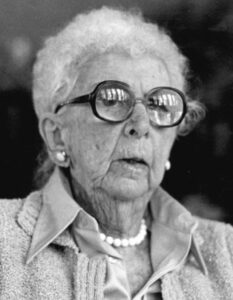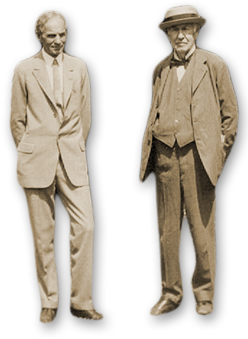Historical Connection – Marjory Stoneman Douglas
August 7, 2023
By Alexandria Edwards, Marketing and Public Relations Coordinator

Marjory Stoneman Douglas was an activist and pioneer woman who worked tirelessly to protect natural resources in Florida and improve communities around her. Douglas was born in Minneapolis, Minnesota, on April 7, 1890, and moved to Massachusetts with her mother, Lillian, a concert violinist, after her parents separated. She graduated from high school in 1908 and continued her studies at Wellesley College, where she studied English literature. She excelled in her studies and was elected class orator at her graduation in 1912. Her greatest inspiration was her grandmother, a marvelous storyteller, who inspired her to pursue her career as a writer.
Douglas’ father, Frank Bryant Stoneman, a judge and newspaper editor, founded the Miami News Record (renamed the Miami Herald in 1910). Marjory worked for the paper as a society reporter and editor. She produced write-ups of weddings, pink teas, and stories that were unique to the community, as well as her own editorial pieces and stories. In 1920, Frank Stoneman offered Douglas a job as the assistant editor of the Miami Herald. She established a column called “The Gallery,” which included information about the consequences of Florida’s rapid development, landscape, and geography – a preview of her later work to protect the state’s natural resources.
When the United States entered World War l in 1917, Douglas enlisted in the Naval Reserve while she was writing for The Herald. She became a yeoman first class in the navy and was stationed in Miami. After a year, she was discharged and then served for the American Red Cross in Paris, writing stories about the organization and her team’s work.
Not only was Douglas concerned about the environment, but also women’s equality and civil rights. She met many influential individuals during her early career and accompanied Mrs. William Jennings Bryan, Mrs. Napoleon Bonaparte Broward, Mrs. William Sherman Jennings, and Mrs. Frank Stranahan to Tallahassee to lobby before the legislature on behalf of women’s suffrage. According to Douglas, “We all five spoke. Mrs. Bryan made one of the best speeches I ever heard.” By 1916, she helped organize the Women’s Business League chapter in Miami and became its first president.
In 1923, she resigned from the Miami Herald and focused on freelance writing. Her pieces were published in The Saturday Evening Post, Collier’s, and Woman’s Home Companion. For nearly 30 years, she produced short stories, unsigned editorials, and poems. She came in second place for the prestigious O. Henry Memorial Prize for short stories in 1928. In honor of her centennial, the University of North Florida Press issued “Nine Florida Stories by Marjory Stoneman Douglas,” a sampling of some of her magazine pieces from the 1920s, 30s and 40s.
Her tales were usually set among the sawgrass and scrub, and plenty of readers in northern cities got their first glimpse of South Florida through her sharp and forgiving eyes. Douglas also taught at the University of Miami from 1925-1929 and served on the editorial board of the University of Miami Press. In 1951, she published her first novel titled “Road to the Sun,” set in Florida in 1845 – the year the state joined the union – followed by the history of Florida and a biography of the environmentalist, W.H. Hudson.
Douglas was most noted for serving on a park committee that supported efforts to designate the Everglades as a National Park, and it officially opened in 1947. The committee was led by Ernest F. Coe, and other members including David Fairchild, and John Olive LaGorce of National Geographic magazine. Douglas visited the Everglades often, and in the Ten Thousand Islands, she saw “great flocks of birds, amazing flights of 30,000 to 40,000 in one swoop.” In 1942, one of her long-time friends, Hervey Allen, an editor for Rinehart and Company, dropped by her house and asked her to write a book about the Miami River. She inquired if she could write about the Everglades that connected to the river, which initiated Marjory’s research on the Everglades ecosystem. Five years later, she published the book “The Everglades: River of Grass,” a blend of local history and insight on the magical place. It highlighted the unique wildlife of the Everglades, home to ibises, spoonbills, manatees, saltwater crocodiles, freshwater alligators, and many other creatures.
In the 1950s, the U.S. Army Corps of Engineers designed a complex system of canals, levees, dams, and pump stations in the Everglades to protect the land from seasonal flooding. Douglas recognized that this unique area was a system that depended not only on the flow of water from Lake Okeechobee into the Everglades but also on the Kissimmee River that feeds the lake. In 1969, she formed the Friends of the Everglades to create awareness of the destruction that this system could cause the fragile river of grass. Throughout the remainder of her life, she expanded the organization into Broward, Palm Beach, Lee, St. Lucie, Osceola, Hendry, Glades, and Monroe counties.
In his introduction to her autobiography “Voice of the River,” John Rothchild described her appearance in a 1973 meeting, stating, “Mrs. Douglas was half the size of her fellow speakers and she wore huge dark glasses, which along with the huge floppy hat made her look like Scarlet O’Hara as played by Igor Stravinsky. She reminded us all of our responsibility to nature, and I don’t remember what else.”

Today, many birds can be found at the Estates.
When Thomas Edison celebrated his birthday in Fort Myers, reporters would interview the inventor and ask him questions about the topics of the day. One reporter who showed up to Edison’s birthday interview in 1928 to speak with Mina Edison was Marjory Douglas. She was impressed by Mina’s ability to manage her Fort Myers’ estate, support the world-famous inventor with such grace and give back to the community. Douglas published the interview in McCall’s magazine.
In 1985, Douglas went on to establish the Biscayne Nature Center at the age of 95. It began as a summer camp for students in Crandon Park and was one of the first hands-on environmental programs at Dade County schools. She went before the county school board and declared that the nature center needed a building of its own. She established a portable classroom and planned a community facility in Crandon Park. In 1991, the State of Florida Department of Education awarded the Marjory Stoneman Douglas Biscayne Nature Center 1.8 million dollars for the construction of the center in the park. When it opened, Douglas stated, “It is my hope that all who come to visit the nature center will leave with a better understanding and appreciation of this area.”
Douglas’ efforts to care for nature did not go unrecognized. In 1975 and 1976, the Florida Audubon Society and Florida Wildlife Federation named Douglas as Conservationist of the Year. She also received a Wellesley College Alumnae Achievement award and was named the honorary vice president of the Sierra Club. To support her work, congress passed the Marjory Stoneman Douglas Everglades Protection Act in 1991, which funded water treatment facilities in the area.
Lastly, in 1993, President Clinton awarded her the President Medal of Freedom with the citation, “an extraordinary woman who has devoted her long life to protecting fragile systems of the Everglades, and to the cause of equal rights for all Americans, Marjory Stoneman Douglas personifies commitment. Her crusade to preserve and restore the Everglades has enhanced our Nation’s respect for our precious environment, reminding all of us of nature’s delicate balance.”
We hope that when you visit the Estates, you will reflect on the beautiful things that nature has to offer. As you stroll the gardens, take time to observe the flowers and wildlife. To learn more about Douglas, listen to Holly Shaffer’s Digital Discussion on August 15 at 10:30 a.m. (it will also be available on YouTube at a later date).


